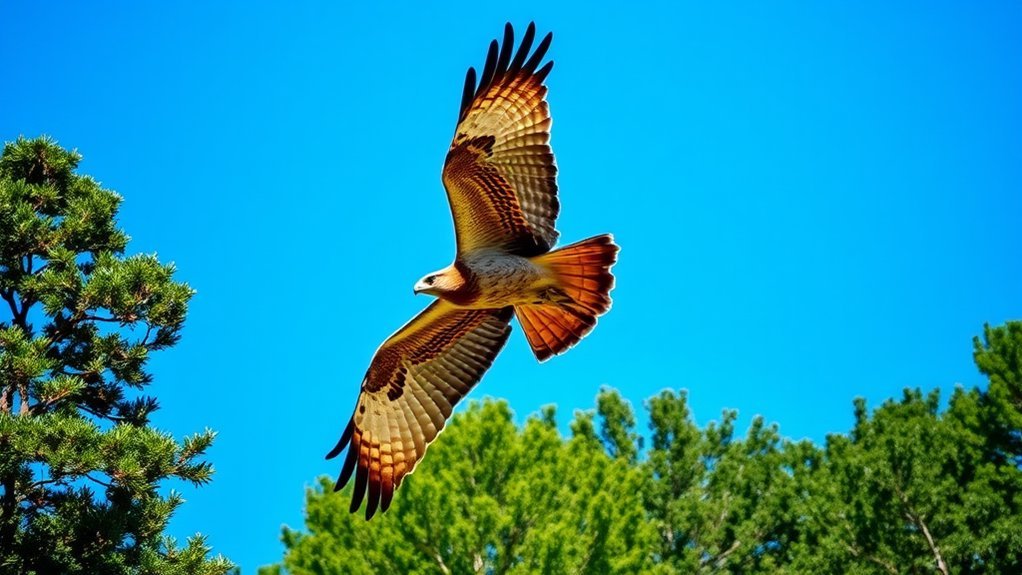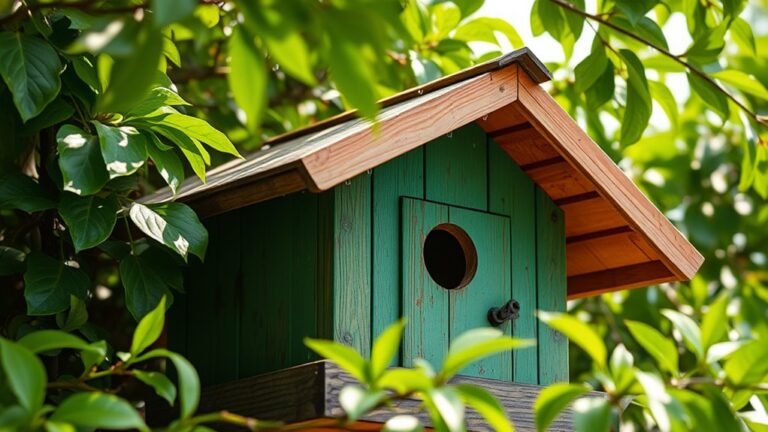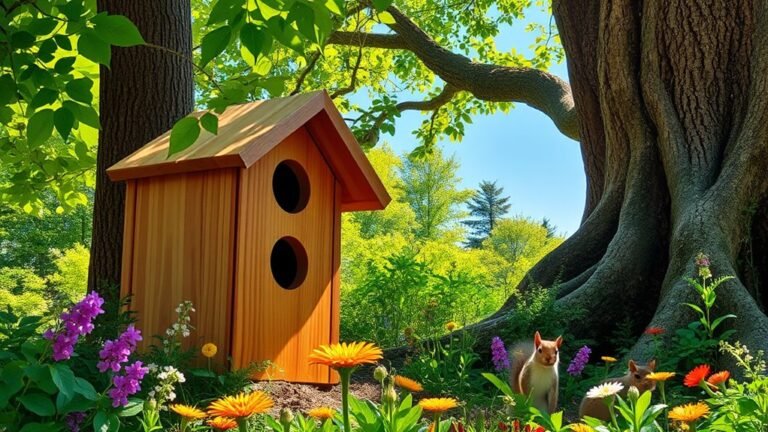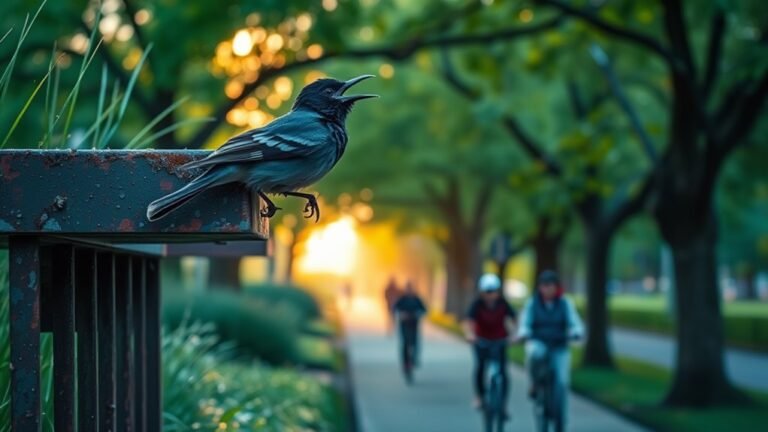Birds of Prey in North Carolina: Raptors of the Skies
In North Carolina, raptors soar in the sky and show impressive skills in hunting. Each species, like the Bald Eagle and the Peregrine Falcon, has a specific role in nature. Watching how they behave teaches us about their survival tactics and how they connect with their environment. Learning about these birds enhances our appreciation for them and highlights the need for conservation. How do these stunning birds affect their habitat, and what difficulties do they face today?
Key Takeaways
North Carolina is home to over 25 types of raptors. These birds show a variety of hunting methods in different habitats. The Bald Eagle represents strength and adaptability and usually nests near water where fish are plentiful. The Red-Tailed Hawk is skilled at spotting prey from a distance and helps keep the ecosystem balanced. Unique hunters like the Peregrine Falcon and Cooper's Hawk use special techniques in both cities and natural settings. Conservation efforts and birdwatching spots in North Carolina are vital for protecting these raptors and their habitats. Enjoying raptor watching can also deepen your appreciation for these incredible birds and their roles in the environment.
Overview of Raptors in North Carolina

North Carolina hosts over 25 species of raptors. These birds of prey thrive in various habitats, such as coastal marshes and mountainous areas.
Each species demonstrates unique hunting behaviors that are suited to its environment. Watching how they hunt showcases their skills.
Many raptors, like the broad-winged hawk, migrate thousands of miles to find warmer climates. This journey highlights their strong survival instincts.
Understanding their behaviors and migrations helps us appreciate the role they play in maintaining ecological balance. Learning about these raptors connects us to nature and enhances our appreciation of North Carolina's diverse wildlife.
The Bald Eagle: Symbol of Strength
The bald eagle is a powerful symbol of strength and resilience. With its striking white head and impressive wingspan, this bird captivates many.
In North Carolina, bald eagles prefer to nest near large bodies of water like lakes and rivers, where fish are abundant. Watching them fly high in the sky, they use their keen eyesight to hunt.
During breeding season, eagles perform unique courtship rituals that help them bond.
They adapt well to different environments, demonstrating their ability to survive. Seeing bald eagles in your area deepens your connection to nature and its enduring spirit.
Red-Tailed Hawk: Master of Adaptation

The red-tailed hawk adapts well to different environments in North Carolina. It thrives in forests, fields, and cities.
This bird has excellent eyesight, allowing it to spot prey from far away. Its large wings help it soar gracefully on rising air currents.
The hawk often hunts by sitting high on a branch to watch for movement or by hiding to surprise its prey. It effectively captures small mammals and birds, showing its skill as a predator.
The red-tailed hawk demonstrates how adaptable it's in various habitats, making it a key part of the ecosystem.
Cooper's Hawk: Stealthy Hunter
The Cooper's hawk is a skilled hunter that thrives in North Carolina's varied landscapes. You can see its unique hunting style as it flies through thick bushes, surprising songbirds.
This bird of prey has excellent flying skills that help it move easily among trees, making it effective in both city and suburban areas.
Cooper's hawks build large stick nests in tall trees. The female usually lays three to five eggs.
Both parents help catch food for their chicks. Learning about these behaviors shows how Cooper's hawks fit into North Carolina's ecosystem.
Peregrine Falcon: The Fastest Bird

The Peregrine Falcon is the fastest bird, known for its impressive speed. It can reach over 240 mph during its hunting dive. This bird hunts by diving from high places to catch unsuspecting birds in mid-air.
In North Carolina, the Peregrine Falcon migrates regularly, covering long distances to find suitable living areas. Watching them in the wild shows their agility and skill, making them important for the local ecosystem.
Their unique plumage helps them blend into different environments. Understanding the role of the Peregrine Falcon enhances your appreciation for North Carolina's wildlife.
You can also become a supporter of raptor conservation with this knowledge.
Osprey: The Fish Hawk
The Osprey, known as the Fish Hawk, is an impressive hunter that attracts bird watchers and nature lovers. Its unique look and diving abilities make it a favorite sight along North Carolina's rivers and lakes.
Here are some key facts about the Osprey:
- Nesting Habits: Ospreys create large nests near water. They use sticks, seaweed, and sometimes human-made materials.
- Diet: These birds mainly eat fish. They've incredible skill in catching fish from the water.
- Migration Patterns: Some Ospreys stay in North Carolina year-round, while others migrate south for the winter. This shows their ability to adapt to different weather.
The Osprey's beauty and hunting skill make it a remarkable bird to observe in the wild.
Barred Owl: The Nocturnal Predator
The Barred Owl is a nocturnal predator that comes alive at night. This bird prefers mature forests, dense wetlands, and open fields. Barred Owls thrive in these areas because of the tall trees and plenty of underbrush.
These owls are known for their sharp hearing, which they use to find food. They mainly hunt small mammals and birds. Their distinctive call, a series of rhythmic hoots, helps them establish territory and attract potential mates.
When exploring their habitats, you may see their pale feathers blending into the shadows, allowing them to camouflage effectively. The Barred Owl truly represents the intrigue of North Carolina's nighttime wildlife.
Turkey Vulture: Nature's Clean-Up Crew
The Turkey Vulture plays a key role in ecosystems in North Carolina. It helps keep the environment clean and supports the food web by eating dead animals.
Here are the main benefits of Turkey Vultures:
- Disease Control: These birds eat decomposing animals, which lowers the chance of diseases spreading.
- Nutrient Recycling: Their feeding habits enrich the soil, helping plants to grow.
- Ecological Balance: Turkey Vultures help control the population of certain animals by consuming carrion.
Northern Harrier: Grace in Flight
In North Carolina, you may observe the Northern Harrier soaring over wetlands and fields.
This bird flies low and hunts small mammals and birds with skill. Its long wings and unique tail shape help it maneuver with ease.
During migration, the Northern Harrier travels significant distances to find warmer places and plentiful food. Its sharp eyesight allows it to spot prey accurately, making it a skilled hunter.
The presence of the Northern Harrier in North Carolina contributes to the diversity of birdlife in the area, encouraging you to appreciate the ecosystems that support these remarkable birds.
Watching them can deepen your connection to nature.
Habitat and Conservation Efforts
As you explore the landscapes of North Carolina, pay attention to birds of prey like the Northern Harrier. They need specific habitats for nesting and hunting.
Unfortunately, habitat loss is a major threat to their populations. To help protect these beautiful birds, you can:
- Join local habitat restoration projects.
- Support policies that protect natural spaces.
- Teach your community about the importance of raptors in our ecosystem.
Getting involved can make a difference for raptors and their habitats. Your actions can help ensure these majestic birds continue to thrive.
Best Locations for Birdwatching in North Carolina
North Carolina is an excellent place for birdwatching. The state has a variety of habitats that attract birds of prey throughout the year.
In the Great Smoky Mountains, you can find birdwatching trails that offer views of migrating hawks and eagles. Ocracoke Island, located in the coastal plains, is perfect for spotting ospreys and kestrels flying along the beach.
The wetlands in the Outer Banks are also popular, especially during migration seasons, making them great spots to see different raptors.
Each of these locations allows you to connect with nature. You can observe bird behaviors and movements, which helps you appreciate the ecosystems they live in.
Frequently Asked Questions
What Time of Year Is Best for Spotting Raptors in North Carolina?
The best times to spot raptors in North Carolina are during the fall and spring. In these seasons, many raptors migrate, allowing for excellent viewing opportunities. During fall, many species head south, while in spring, they return north. Observers can enjoy watching these impressive birds in action as they travel. Keep an eye out on clear days, especially at migration hotspots.
Are There Any Raptor Rehabilitation Centers in North Carolina?
Yes, North Carolina has several raptor rehabilitation centers. These centers help injured birds of prey recover. You can support local wildlife and observe their healing process.
How Can I Attract Raptors to My Backyard?
To attract raptors to your backyard, set up raptor feeders and nesting platforms. Pay attention to local species and their needs. These additions can make your yard a welcoming home for these impressive birds. Enjoy watching their graceful movements and listen to their calls as they thrive in your space.
What Precautions Should I Take While Birdwatching Raptors?
When birdwatching raptors, keep a respectful distance from them. Avoid crowding their space. For raptor photography, respect their habitat. Do not use flash and maintain a safe distance. These actions help ensure your safety and the well-being of the birds. Enjoy birdwatching while being responsible and considerate.
Can I Report Injured or Orphaned Raptors in North Carolina?
Yes, you can report injured raptors in North Carolina. Use local resources that specialize in injured raptors for assistance. If you find an orphaned bird, follow the proper protocols for orphaned birds to ensure they get the care they need. Your actions play a key role in their survival.

Ava is a bird enthusiast and nature lover who has spent countless hours observing and learning about the fascinating world of birds. With a passion for sharing her knowledge and inspiring others to appreciate the beauty of birds, Ava writes about her experiences and insights on avianadmirer.com.







